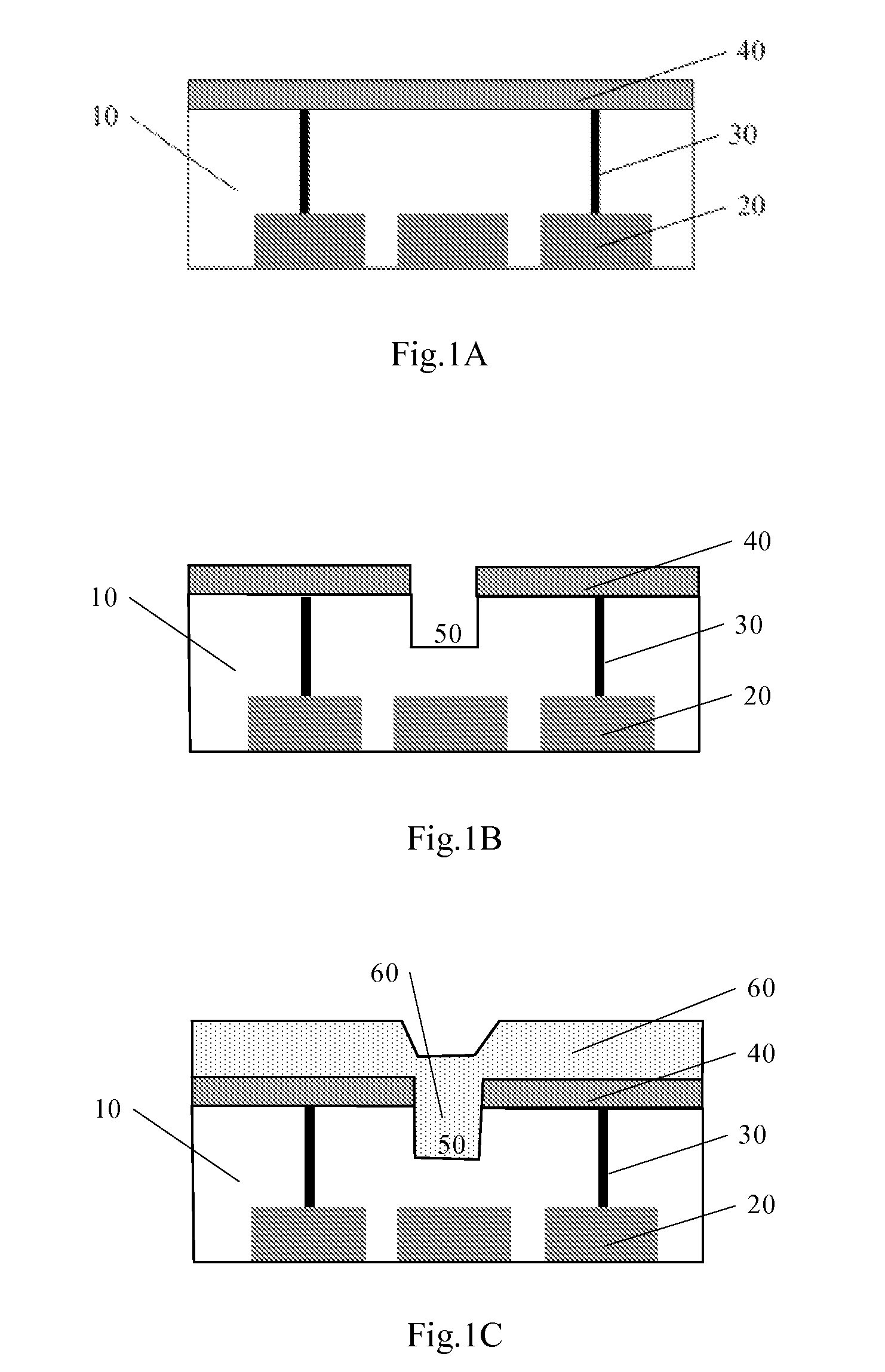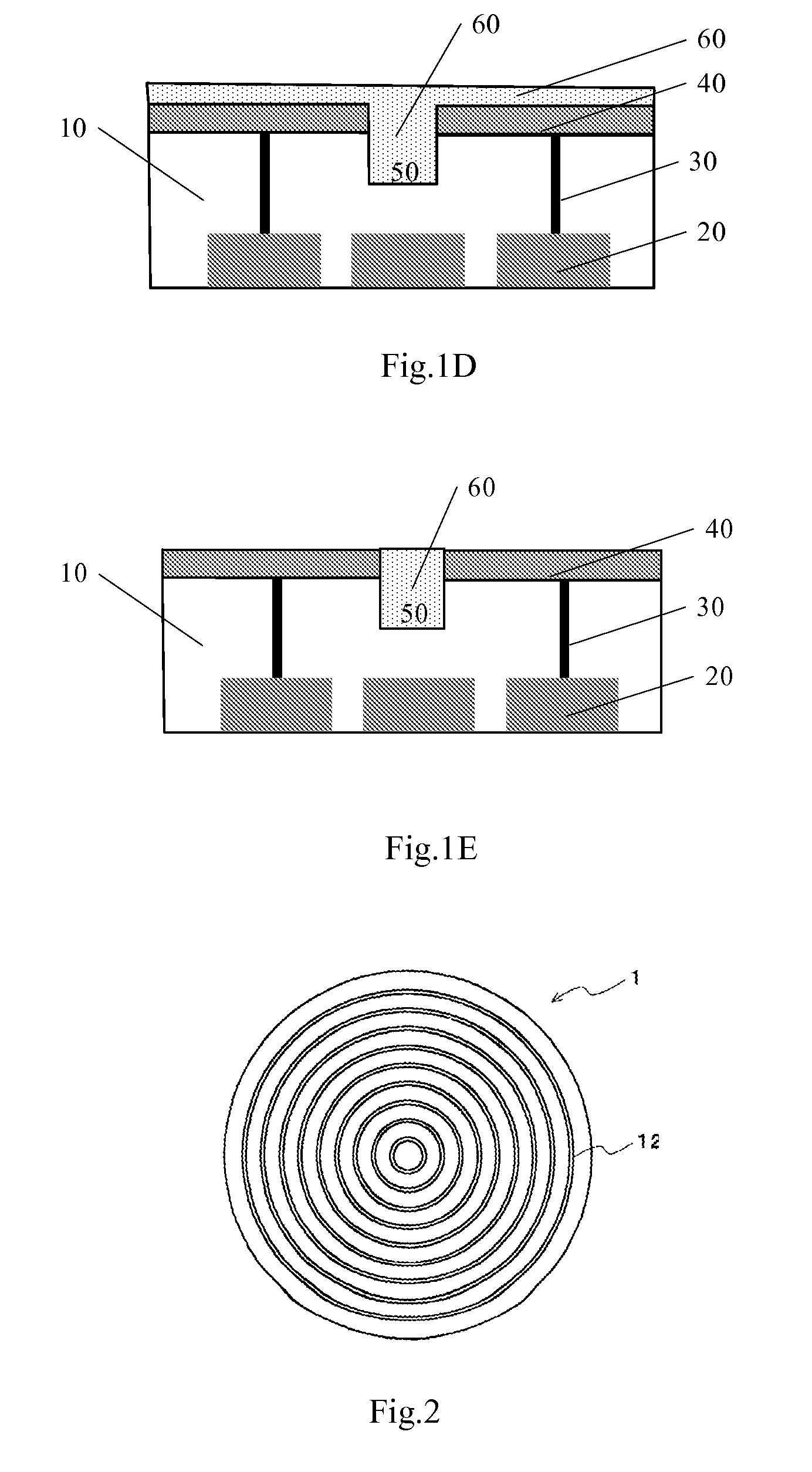Method for planarization of wafer and method for formation of isolation structure in top metal layer
a technology of isolation structure and planarization process, which is applied in the direction of crystal growth process, after-treatment details, instruments, etc., can solve the problems of difficult to meet the requirement for intense distribution of components by single-layer routing, and uneven surface of wafer, so as to improve the display quality of lcos lcd, ensure the surface flatness of the wafer, and improve the display quality
- Summary
- Abstract
- Description
- Claims
- Application Information
AI Technical Summary
Benefits of technology
Problems solved by technology
Method used
Image
Examples
embodiment 1
[0063]The present invention provides a method for planarization of a wafer having a surface layer with recesses, comprising: forming an etching-resist layer on the surface layer to fill the recess and the thickness of the etching-resist layer in the recess is larger than that outside the recess; etching the etching-resist layer and the surface layer; wherein, the etching speed of the surface layer is higher than that of the etching-resist layer, so that the portions of the surface layer outside the recess will not be higher than the bottom of recess after etching; and removing the etching-resist layer.
[0064]As shown in FIG. 4A, a wafer having a semiconductor substrate 100 is provided; the semiconductor substrate 100 may be applied to semiconductor manufacturing processes, and may have devices and circuits formed therein. Due to the fact that different devices and circuits may be contained in different structures depending on the specific manufacturing processes, the internal structu...
embodiment 2
[0072]The present invention also provides a method for planarization of a top metal layer in LCOS, wherein the top metal layer is contained in a wafer and includes a trench and an insulating oxide layer including a recess formed over the trench and the top metal layer, a position of the recess in the insulating oxide layer corresponding to the trench; the method comprises the following steps: forming an etching-resist layer over the insulating oxide layer to fill the recess, the thickness of the etching-resist layer in the recess being larger than that outside the recess; etching the etching-resist layer and the insulating oxide layer, wherein the etching speed of the insulating oxide layer is higher than that of the etching-resist layer, so that the insulating oxide layer outside the recess will not be higher than the bottom of the recess; removing the etching-resist layer; and etching the insulating oxide layer till the top metal layer is exposed completely.
[0073]As shown in FIG. ...
embodiment 3
[0081]The present invention also provides a method for planarization of a top metal layer in LCOS, wherein a wafer having an ILD layer and a top metal layer formed over the ILD layer is provided, the method comprising the following steps: etching the top metal layer and the ILD layer to a predetermined depth, to form a trench in the top metal layer and the ILD layer; forming an insulating oxide layer over the top metal layer and the trench so as to fill the trench, the insulating oxide layer having a recess at a position corresponding to the trench; forming an etching-resist layer over the insulating oxide layer to fill the recess, and a thickness of the etching-resist layer in the recess is larger than that outside the recess; etching the etching-resist layer and the insulating oxide layer, the etching speed of the insulating oxide layer being higher than that of the etching-resist layer, so that the insulating oxide layer outside the recess will not be higher than the bottom of th...
PUM
| Property | Measurement | Unit |
|---|---|---|
| thickness | aaaaa | aaaaa |
| flatness | aaaaa | aaaaa |
| insulating | aaaaa | aaaaa |
Abstract
Description
Claims
Application Information
 Login to View More
Login to View More - R&D
- Intellectual Property
- Life Sciences
- Materials
- Tech Scout
- Unparalleled Data Quality
- Higher Quality Content
- 60% Fewer Hallucinations
Browse by: Latest US Patents, China's latest patents, Technical Efficacy Thesaurus, Application Domain, Technology Topic, Popular Technical Reports.
© 2025 PatSnap. All rights reserved.Legal|Privacy policy|Modern Slavery Act Transparency Statement|Sitemap|About US| Contact US: help@patsnap.com



